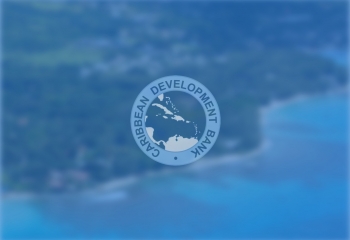The Caribbean Development Bank (CDB) is projecting regional economies to grow by an average 2 % this year with expansions expected in all 19 Borrowing Member Countries (BMCs).
As was the case last year, most are set to grow by between 1% and 3% with strongest performances expected in Tourism and Construction, along with some improvement in commodity exports.
The Bank's preliminary forecast also reflects an anticipation of moderate improvements in the economies of the region's major trading partners, officials told a press conference in Barbados today.
According to the Bank, while its preliminary estimate of regional growth in real Gross Domestic Product (GDP) of 1.3% for last year is slightly lower than the revised figure of 1.7% for 2013, there is cautious optimism of further strengthening of the regional recovery.
Fastest growth rates for 2014 were estimated for the more Tourism-dependent economies. St. Kitts and Nevis and the Turks and Caicos Islands (TCI) for example, each experienced accelerated growth of around 4%, based on the strengthening recovery in Tourism and continued investment inflows for mainly Tourism and real estate-related Construction.
In fact, the CDB says almost all regional destinations for which data were available recorded increased visitor arrivals last year.
Meanwhile, despite falling commodity prices and other challenges that impacted mining and quarrying activity, some large commodity exporters were also able to grow quite rapidly, although driven by the services sector.
There were a few exceptions to the overall economic recovery, however. Trinidad and Tobago, which accounts for nearly a third of the Region's total GDP, slowed considerably to record modest growth last year. The CDB says this came in the wake of operational challenges and the significant drop in oil prices during the year which suppressed petroleum output, thereby driving a decline in the mining and quarrying sector.
In a few other BMCs, continued underperformance in key sectors contributed to flat or declining economic activity. Barbados and the British Virgin Islands (BVI) stagnated for the seventh consecutive year in 2014. Marginal growth was estimated for Barbados, as weak performances in Tourism, international business and Construction were not enough to compensate for declines in manufacturing and agriculture.
Elsewhere, sizeable economic contractions in St. Lucia and St. Vincent and the Grenadines in 2014 partly reflected the impact of a severe storm just before the start of the year, which worsened pre-existing, chronic weaknesses in critical sectors.
Referring to the other major sector contributing to the regional recovery, the CDB said continued expansion in Construction activity in most BMCs was primarily led by the private sector. Much of this was related to Tourism and other commercial development, as well as strong growth in residential building in some territories. Growth in the sector was also stimulated by public sector capital investment in several countries.
The CDB reported mixed performances in manufacturing, with three of the top five regional manufacturers showing moderate-to-strong growth and two declining. Solid expansion in the non-petroleum segment of the sector in Trinidad and Tobago was boosted by the economic recovery in the rest of the Region. This heightened demand for its export products, including food, beverages, chemicals and especially cement, consistent with the upward trend in Construction. Haiti and Guyana were the other two major manufacturers that posted growth.
According to the CDB, agriculture also had mixed fortunes, with some of the major agro-producers reporting robust growth, whereas adverse weather conditions and crop disease negatively affected others.
Labour market conditions were largely a reflection of the general improvement in real sector activity, with unemployment rates falling in several BMCs. Although, generally unemployment levels remain stubbornly high.The Bank also reported improvements in foreign exchange reserves. Preliminary indications are that external current account balances in most BMCs were positively influenced by the strengthening recovery in Tourism, in terms of travel receipts, as well as continued inflows of remittances. However, the reduction in international commodity prices had both positive and negative effects on merchandise trade balances, reducing import bills in most BMCs, but also curtailing export proceeds among major commodity exporters.
There were indications too of most BMCs benefitting from increases in foreign direct investment (FDI), particularly for Tourism-related Construction. Consequently, foreign exchange reserves rose in The Bahamas, Belize, the ECCU, Jamaica and Trinidad and Tobago, representing significant turnarounds in performance in The Bahamas and Jamaica relative to deteriorating reserve positions in 2013. Reserves fell for another year in Barbados, Guyana, Haiti and Suriname.
The CDB notes, however, that notwithstanding the ongoing recovery and positive outlook for 2015, the need for further fiscal consolidation and greater savings means that much of the impetus for growth and job creation must come from the private sector, including through FDI.
It says the private sector will also have to shoulder more of the financial burden of investing in the Region's social and economic infrastructure. To encourage this, the CDB says it is rolling out new facilities to support BMCs that are increasingly turning to public-private partnerships (PPPs).
At the same time, the Bank is urging governments to undertake structural and other reforms to create the kind of legal and regulatory environment and broader governance framework that can attract investment, and within which the private sector can truly become the main engine of growth.
Overview
Strong 2014 performance in Tourism and Construction
Foreign exchange reserves generally record increases
Mixed performance in manufacturing and agriculture
Unemployment still high but falls in some territories
CAPTION: Today, February 18, 2015, Caribbean Development Bank's (CDB) President, Dr. Warren Smith (right) and Dr. Justin Ram, Director of Economics met with the journalists from across the Region to discuss the short to medium-term prospects for the economies of the Bank's borrowing member countries (BMCs).




